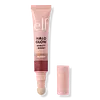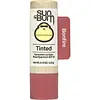What's inside
What's inside
 Key Ingredients
Key Ingredients

 Benefits
Benefits

 Concerns
Concerns

 Ingredients Side-by-side
Ingredients Side-by-side

Water
Skin ConditioningHydrogenated Didecene
Skin ConditioningIsododecane
EmollientSynthetic Fluorphlogopite
Glycerin
HumectantPropylene Glycol
HumectantPEG-10 Dimethicone
Skin ConditioningTrimethylsiloxysilicate
EmollientSqualane
EmollientCetyl PEG/PPG-10/1 Dimethicone
EmulsifyingDimethicone
EmollientIsoamyl Laurate
EmollientHydrogenated Styrene/Isoprene Copolymer
Sodium Chloride
MaskingSynthetic Sapphire
Caprylic/Capric Triglyceride
MaskingPolyglyceryl-4 Isostearate
EmulsifyingPropylene Carbonate
SolventDisteardimonium Hectorite
StabilisingTocopherol
AntioxidantHelianthus Annuus Seed Oil
EmollientCalendula Officinalis Flower Extract
MaskingSilica
AbrasivePolymethylsilsesquioxane
Hydrolyzed Sodium Hyaluronate
Skin ConditioningSodium Hyaluronate
HumectantDisodium EDTA
Triethoxycaprylylsilane
Caprylyl Glycol
EmollientPhenoxyethanol
PreservativeEthylhexylglycerin
Skin ConditioningPentaerythrityl Tetra-Di-T-Butyl Hydroxyhydrocinnamate
AntioxidantTin Oxide
AbrasiveCI 77891
Cosmetic ColorantCI 77491
Cosmetic ColorantWater, Hydrogenated Didecene, Isododecane, Synthetic Fluorphlogopite, Glycerin, Propylene Glycol, PEG-10 Dimethicone, Trimethylsiloxysilicate, Squalane, Cetyl PEG/PPG-10/1 Dimethicone, Dimethicone, Isoamyl Laurate, Hydrogenated Styrene/Isoprene Copolymer, Sodium Chloride, Synthetic Sapphire, Caprylic/Capric Triglyceride, Polyglyceryl-4 Isostearate, Propylene Carbonate, Disteardimonium Hectorite, Tocopherol, Helianthus Annuus Seed Oil, Calendula Officinalis Flower Extract, Silica, Polymethylsilsesquioxane, Hydrolyzed Sodium Hyaluronate, Sodium Hyaluronate, Disodium EDTA, Triethoxycaprylylsilane, Caprylyl Glycol, Phenoxyethanol, Ethylhexylglycerin, Pentaerythrityl Tetra-Di-T-Butyl Hydroxyhydrocinnamate, Tin Oxide, CI 77891, CI 77491
Homosalate 10%
Skin ConditioningEthylhexyl Salicylate 5%
UV AbsorberOctocrylene 3%
UV AbsorberZinc Oxide 2.85%
Cosmetic ColorantBeeswax
Emulsion StabilisingCocos Nucifera Oil
MaskingButyrospermum Parkii Butter
Skin ConditioningRicinus Communis Seed Oil
MaskingOlea Europaea Fruit Oil
MaskingCaprylic/Capric Triglyceride
MaskingTheobroma Grandiflorum Seed Butter
Skin ConditioningCopernicia Cerifera Wax
Euphorbia Cerifera Wax
Aroma
Mica
Cosmetic ColorantTitanium Dioxide
Cosmetic ColorantCI 75470
Cosmetic ColorantHelianthus Annuus Seed Oil
EmollientOctyldodecyl Oleate
EmollientCI 77492
Cosmetic ColorantLimnanthes Alba Seed Oil
Skin ConditioningAloe Barbadensis Leaf Extract
EmollientSimmondsia Chinensis Seed Oil
EmollientCarthamus Tinctorius Seed Oil
MaskingTocopherol
AntioxidantJojoba Esters
EmollientIndigofera Tinctoria Leaf Extract
Skin ConditioningPolyhydroxystearic Acid
EmulsifyingStevia Rebaudiana Extract
Tin Oxide
AbrasiveSilica
AbrasiveHomosalate 10%, Ethylhexyl Salicylate 5%, Octocrylene 3%, Zinc Oxide 2.85%, Beeswax, Cocos Nucifera Oil, Butyrospermum Parkii Butter, Ricinus Communis Seed Oil, Olea Europaea Fruit Oil, Caprylic/Capric Triglyceride, Theobroma Grandiflorum Seed Butter, Copernicia Cerifera Wax, Euphorbia Cerifera Wax, Aroma, Mica, Titanium Dioxide, CI 75470, Helianthus Annuus Seed Oil, Octyldodecyl Oleate, CI 77492, Limnanthes Alba Seed Oil, Aloe Barbadensis Leaf Extract, Simmondsia Chinensis Seed Oil, Carthamus Tinctorius Seed Oil, Tocopherol, Jojoba Esters, Indigofera Tinctoria Leaf Extract, Polyhydroxystearic Acid, Stevia Rebaudiana Extract, Tin Oxide, Silica
 Reviews
Reviews

Ingredients Explained
These ingredients are found in both products.
Ingredients higher up in an ingredient list are typically present in a larger amount.
This ingredient is an emollient, solvent, and texture enhancer. It is considered a skin-softener by helping the skin prevent moisture loss.
It helps thicken a product's formula and makes it easier to spread by dissolving clumping compounds.
Caprylic Triglyceride is made by combining glycerin with coconut oil, forming a clear liquid.
While there is an assumption Caprylic Triglyceride can clog pores due to it being derived from coconut oil, there is no research supporting this.
Learn more about Caprylic/Capric TriglycerideHelianthus Annuus Seed Oil is the oil derived from the seeds of a Sunflower. Sunflower seed oil is non-fragrant. It is an emollient, meaning it helps to soften the skin.
Sunflower seed oil contains many fatty acids. The fatty acids found in sunflower seeds include (from highest amount to least): linoleic acid, myristic acid, palmitic acid, stearic acid, arachidic acid, oleic acid, and linolenic acid.
These fatty acids help the skin create ceramides. Ceramides play a role in repairing the skin barrier.
Helianthus Annuus Seed Oil helps moisturize the skin. This in turn helps the skin look more rejuvenated and smoother.
Sunflowers are rich in vitamin E.
Historians believe Indigenous cultures of North America domesticated sunflowers before corn. Thus they relied on sunflower oil for a variety of uses. One such use is moisturizing skin and hair.
Sunflower seed oil may not be fungal acne safe. We recommend speaking with a professional if you have any concerns.
Learn more about Helianthus Annuus Seed OilSilica, also known as silicon dioxide, is a naturally occurring mineral. It is used as a fine, spherical, and porous powder in cosmetics.
Though it has exfoliant properties, the function of silica varies depending on the product.
The unique structure of silica enhances the spreadability and adds smoothness, making it a great texture enhancer.
It is also used as an active carrier, emulsifier, and mattifier due to its ability to absorb excess oil.
In some products, tiny microneedles called spicules are made from silica or hydrolyzed sponge. When you rub them in, they lightly polish away dead skin layers and enhance the penetration of active ingredients.
Learn more about SilicaTin Oxide is an inorganic oxide used to add opacity and volume to a product. In nature, it is already found in mineral form. The main ore of tin is an opaque and shiny mineral called casseterite.
Tin Oxide helps remove translucency in a product, or make it more opaque. Besides adding opacity, tin oxide is used for bulking to add volume.
Tocopherol (also known as Vitamin E) is a common antioxidant used to help protect the skin from free-radicals and strengthen the skin barrier. It's also fat soluble - this means our skin is great at absorbing it.
Vitamin E also helps keep your natural skin lipids healthy. Your lipid skin barrier naturally consists of lipids, ceramides, and fatty acids. Vitamin E offers extra protection for your skin’s lipid barrier, keeping your skin healthy and nourished.
Another benefit is a bit of UV protection. Vitamin E helps reduce the damage caused by UVB rays. (It should not replace your sunscreen). Combining it with Vitamin C can decrease sunburned cells and hyperpigmentation after UV exposure.
You might have noticed Vitamin E + C often paired together. This is because it is great at stabilizing Vitamin C. Using the two together helps increase the effectiveness of both ingredients.
There are often claims that Vitamin E can reduce/prevent scarring, but these claims haven't been confirmed by scientific research.
Learn more about Tocopherol